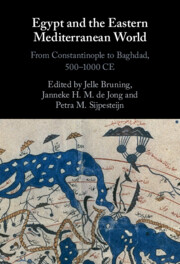Book contents
- Egypt and the Eastern Mediterranean World
- Egypt and the Eastern Mediterranean World
- Copyright page
- Contents
- Figures, Graphs, and Tables
- Notes on Contributors
- Notes on Transliteration, Names, and Dates
- Preface and Acknowledgments
- Additional material
- Introduction
- Part I Political and Administrative Connections
- Chapter 1 Egypt in the Age of Justinian: Connector or Disconnector?
- Chapter 2 At the Crossroads of Regional Settings: Egypt, 500–1000 CE
- Chapter 3 The Frontier Zone at the First Cataract before and at the Time of the Muslim Conquest (Fifth to Seventh Centuries)
- Chapter 4 Islamic Historiography on Early Muslim Relations with Nubia
- Chapter 5 Local Tradition and Imperial Legal Policy under the Umayyads: The Evolution of the Early Egyptian School of Law
- Chapter 6 Ibn Ṭūlūn’s Pacification Campaign: Sedition, Authority, and Empire in Abbasid Egypt
- Part II Economic Connections
- Part III Social and Cultural Connections
- Index
- References
Chapter 4 - Islamic Historiography on Early Muslim Relations with Nubia
from Part I - Political and Administrative Connections
Published online by Cambridge University Press: 01 December 2022
- Egypt and the Eastern Mediterranean World
- Egypt and the Eastern Mediterranean World
- Copyright page
- Contents
- Figures, Graphs, and Tables
- Notes on Contributors
- Notes on Transliteration, Names, and Dates
- Preface and Acknowledgments
- Additional material
- Introduction
- Part I Political and Administrative Connections
- Chapter 1 Egypt in the Age of Justinian: Connector or Disconnector?
- Chapter 2 At the Crossroads of Regional Settings: Egypt, 500–1000 CE
- Chapter 3 The Frontier Zone at the First Cataract before and at the Time of the Muslim Conquest (Fifth to Seventh Centuries)
- Chapter 4 Islamic Historiography on Early Muslim Relations with Nubia
- Chapter 5 Local Tradition and Imperial Legal Policy under the Umayyads: The Evolution of the Early Egyptian School of Law
- Chapter 6 Ibn Ṭūlūn’s Pacification Campaign: Sedition, Authority, and Empire in Abbasid Egypt
- Part II Economic Connections
- Part III Social and Cultural Connections
- Index
- References
Summary
Muslim and Orientalist historians alike have long presented the Islamic conquests as having happened very quickly. They depict them as a rapid expansion in which the old and declining Byzantine and Sasanian empires could not offer serious resistance to the brand-new Muslim armies. However, if the conquests of the central lands (Syria, Iraq, and Egypt) were swift, it took the Muslim armies considerably longer to conquer North Africa and the Iberian Peninsula. Similarly, it took centuries before the Muslims dominated Christian Nubia. The definitive conquest of the kingdom of Makuria was not made until 675/1276 by the Mamluk sultan Baybars. Despite this prolonged process of establishing their dominance over the region, medieval Muslim historians were reluctant to spell out the fact that the Muslim armies took centuries to be victorious.
- Type
- Chapter
- Information
- Egypt and the Eastern Mediterranean WorldFrom Constantinople to Baghdad, 500-1000 CE, pp. 103 - 130Publisher: Cambridge University PressPrint publication year: 2022



